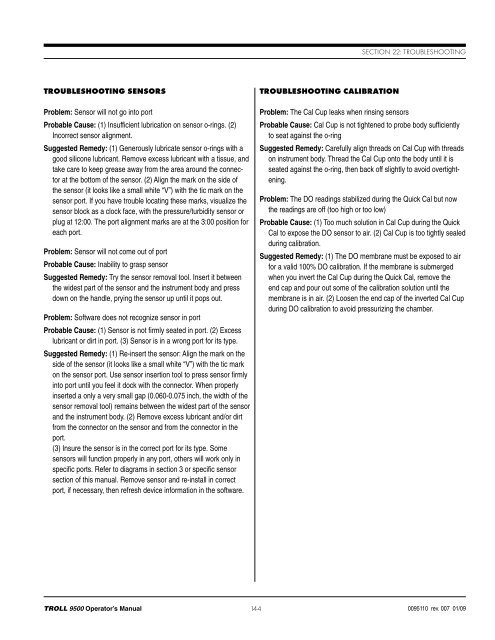TROLL 9500 Operator's Manual - Geotech Environmental Equipment
TROLL 9500 Operator's Manual - Geotech Environmental Equipment
TROLL 9500 Operator's Manual - Geotech Environmental Equipment
Create successful ePaper yourself
Turn your PDF publications into a flip-book with our unique Google optimized e-Paper software.
Section 22: TroubleshootingTroubleshooting SensorsProblem: Sensor will not go into portProbable Cause: (1) Insufficient lubrication on sensor o-rings. (2)Incorrect sensor alignment.Suggested Remedy: (1) Generously lubricate sensor o-rings with agood silicone lubricant. Remove excess lubricant with a tissue, andtake care to keep grease away from the area around the connectorat the bottom of the sensor. (2) Align the mark on the side ofthe sensor (it looks like a small white “V”) with the tic mark on thesensor port. If you have trouble locating these marks, visualize thesensor block as a clock face, with the pressure/turbidity sensor orplug at 12:00. The port alignment marks are at the 3:00 position foreach port.Problem: Sensor will not come out of portProbable Cause: Inability to grasp sensorSuggested Remedy: Try the sensor removal tool. Insert it betweenthe widest part of the sensor and the instrument body and pressdown on the handle, prying the sensor up until it pops out.Problem: Software does not recognize sensor in portProbable Cause: (1) Sensor is not firmly seated in port. (2) Excesslubricant or dirt in port. (3) Sensor is in a wrong port for its type.Suggested Remedy: (1) Re-insert the sensor: Align the mark on theside of the sensor (it looks like a small white “V”) with the tic markon the sensor port. Use sensor insertion tool to press sensor firmlyinto port until you feel it dock with the connector. When properlyinserted a only a very small gap (0.060-0.075 inch, the width of thesensor removal tool) remains between the widest part of the sensorand the instrument body. (2) Remove excess lubricant and/or dirtfrom the connector on the sensor and from the connector in theport.(3) Insure the sensor is in the correct port for its type. Somesensors will function properly in any port, others will work only inspecific ports. Refer to diagrams in section 3 or specific sensorsection of this manual. Remove sensor and re-install in correctport, if necessary, then refresh device information in the software.Troubleshooting CalibrationProblem: The Cal Cup leaks when rinsing sensorsProbable Cause: Cal Cup is not tightened to probe body sufficientlyto seat against the o-ringSuggested Remedy: Carefully align threads on Cal Cup with threadson instrument body. Thread the Cal Cup onto the body until it isseated against the o-ring, then back off slightly to avoid overtightening.Problem: The DO readings stabilized during the Quick Cal but nowthe readings are off (too high or too low)Probable Cause: (1) Too much solution in Cal Cup during the QuickCal to expose the DO sensor to air. (2) Cal Cup is too tightly sealedduring calibration.Suggested Remedy: (1) The DO membrane must be exposed to airfor a valid 100% DO calibration. If the membrane is submergedwhen you invert the Cal Cup during the Quick Cal, remove theend cap and pour out some of the calibration solution until themembrane is in air. (2) Loosen the end cap of the inverted Cal Cupduring DO calibration to avoid pressurizing the chamber.<strong>TROLL</strong> <strong>9500</strong> Operator’s <strong>Manual</strong>144 0095110 rev. 007 01/09
















